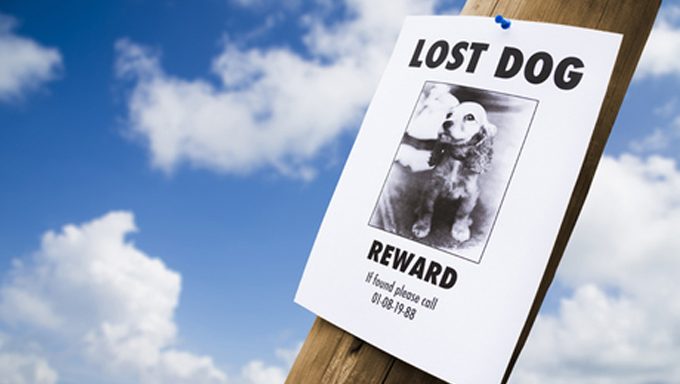(Picture Credit: Picnote/Getty Images)
If your dog gets lost or strays from home, your first instinct is probably to panic. But you need to keep your wits about you and take immediate action if you hope to reunite with your pet.
Ten million dogs and cats go missing every year. It’s one of the most traumatic experiences for pet parents and for their furry family member, as well.
That’s why National Lost Dog Awareness Day, observed on April 23rd, is such an important day for pet owners. We should all take the opportunity to spread the word about the best ways to find lost pets and help them get home.
If you do happen to lose your dog, there are some steps you can take to make sure you’re reunited as soon as possible. Here are a few tips that might help you find a lost dog.
Always Update Your Dog’s Identification

(Picture Credit: Jamie Garbutt/Getty Images)
Before your dog even has a chance of getting lost, you should make sure they can be easily identified. Every lost pet has a better chance of being returned if they always wear a collar with an identification tag that includes their owners’ current name, address, and telephone number.
Pets should also have a microchip for permanent identification. This is a small chip embedded under the skin that can easily be scanned by veterinarians, shelters, and law enforcement. The chip tells anyone who scans it exactly who the pet belongs to and how to contact them, and it can’t fall off like a collar might.
Make sure that you update your dog’s identification every time you move, change phone numbers, or alter your contact information in any way.
Call Shelters, Animal Control, Veterinary Offices, And Authorities
Getting the word out early is the key to getting your dog back safely. Hours count, so take action immediately when your dog goes missing.
Contact the local animal shelter and animal control agencies. File a lost pet report with every shelter within at least a 60-mile radius. Most shelters will take a lost pet report over the phone, and it’s helpful if you can email them a color photo of your dog. Be sure that you give them an accurate description.
Whenever possible, go to the shelter yourself or send a reliable friend. Visit daily to look at all the dogs. Most shelters are reliable, but it’s safer to see for yourself if your dog is there.
Contact all veterinary clinics in your area and any emergency vet clinics. Sometimes people pick up a stray and drive it some distance to a clinic. Email them a photo and description of your dog and ask that they post a lost notice.
If you believe that your dog was stolen, file a police report and follow up with authorities frequently. Provide them with any evidence you might have, including the date and time your pet was taken.
Use Lost Dog Sites And Apps
Use the internet to widen your search. There are sites that may be able to help you out, including the Center for Lost Pets, Fido Finder, Pet Amber Alert, and Lost My Doggie.
Apps like Finding Rover are extremely useful to help you in locating your lost pup. Some apps will help you make fliers, and other apps may use facial recognition software to help search the internet for photos of your lost dog that might be posted by someone else.
Search The Neighborhood

(Picture Credit: Shutterstock)
Walk or drive through your neighborhood daily. Ask every neighbor, letter carrier, and delivery person if they’ve seen your pet. Show them a photo, and give them your phone number in case they see your dog later.
Hand out pictures of your dog with your contact information to everyone so they know what to look for and how to get in touch with you. Make dozens of index cards with this information and a description of your dog, and leave a card at houses and on car windshields if you’re unable to talk directly with homeowners in your area.
As you drive and walk your neighborhood, call your pet by name. Enlist family and friends to do the same, so you can canvas the area thoroughly and frequently.
Make ‘Lost Dog’ Posters
Make fliers–lots of them–and keep them simple and informative. Print “LOST DOG” in bold letters that can be easily read from a distance in the headline, and include a basic description of your pet.
You can offer a reward, but don’t state how much in the ad, and be sure to include your phone number.
Post these notices at traffic intersections, grocery stores, community centers, veterinary offices, and other locations. Get the word out because the more people who know your pet is lost, the more likely it is that someone will spot your dog and contact you.
Make a list of all of the places you’ve posted notices so you can remove them when you recover your pet to avoid having people continue to search for a dog who is safely back home!
Contact Local Media
Some local radio and television stations have “lost pet” alerts–if not on-air, then frequently on their own websites. Ask if you can post the information on your dog so anyone who sees your pet can contact you.
A frightened animal can cover a lot of ground and may end up far from home, so it’s critical that you broaden the search. Consider placing an ad in the local newspaper, too.
Use Social Media And Email

(Picture Credit: Tudor Costache/Getty Images)
Post pictures of your dog to social media, and make sure you set each post so that it can be shared by others. Social media is a great way to get the word out, and both missing pets and people have returned home thanks to communities on social media.
Some people create a Facebook page and post photos daily, asking friends and family to share and get the word out to even more people. Ask everyone to share the information on their feeds and walls.
Use social media to contact local rescue groups in your area, and ask them to also share your dog’s photo on their walls. They’re networked with vast amounts of animal rescue workers in your area who will see the photo and have contact with many homeless or lost dogs through their rescue work.
Email everyone on your own contact list. Send them your dog’s description and photo, and encourage those who can to help you search.
WARNING: Beware Of Scammers

(Picture Credit: Shutterstock)
Be wary of pet-recovery scams. If a stranger contacts you claiming to have your dog, ask them to describe your pet thoroughly before giving out any information.
It’s a good idea to keep some details left off of your Lost Dog fliers. You can use these details for confirmation if contacted by someone on the phone or internet. Be sure they can identify characteristics you left out of your advertising to see if they are trying to scam you or actually have your dog.
Ask them to text or email you a photo of your dog for confirmation, as well. Be especially careful if they insist on payment for the return of your pet or come up with excuses to delay returning your dog. Call police if you notice something suspicious.
They could be running a scam where they actually kidnap dogs and hold them for ransom. You’ll need to get the police involved immediately because these people are professionals at using your emotions to take your money.
Also, it’s common for pet psychics or people claiming to be pet psychics to contact you and say they know where your pet is. They often have a message of “your pet is alive and well, but you may never see them again.”
This may be a misguided effort to make the owner of a lost pet feel better, but do not give them money, either. You can thank them for the message and move on.
Stay Strong
Don’t give up! Try everything and look everywhere. Many animals have been lost for months or years before being found and reunited with their families. Usually this happens thanks to microchip identification.
If you have lost your dog we are so sorry to hear that. Many of us at DogTime have been through this before with varying results. Our hearts go out to anyone who has lost a pet. It’s truly the worst feeling in the world.
Be strong, and know you aren’t alone.
Have you ever reunited with a lost dog? How did you find them? Let us know in the comments below!
Related Articles: